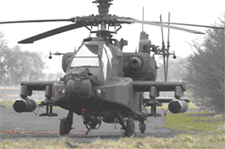
Customized Dynamic Balancing ( CDB )
-
30, July 2008Customized Dynamic Balancing
- UK effort Shake’d Technologies awarded a12 month contract from the UK Ministry of Defence and the Attack Helicopter IPT ... -
24 March, 2008Apache Helicopter Contract Awarded – News Shake’d Technologies has been awarded a 12 month contract from the U.S. Army's AH-64 Apache

Since the inception of the AH-64 fleet, the Apache Program Manager’s (PM)
Office has encountered a number of challenges. These challenges include
logistics and operational readiness, safety of flight, airworthiness and
numerous others inherent in the operation and support of a major aircraft
program.
Perhaps the most significant challenge has been the burden placed on fleet
readiness and maintenance operations and logistics from the excessive wear and
subsequent premature failure of aircraft dynamic components. These components
include the main transmission accessory gearbox, intermediate gearbox (IGB),
tail rotor gearbox, auxiliary power unit (APU) power take-off (PTO) clutch, and
main and tail rotor blades. In addition, issues concerning structural damage to
the aircraft, such as cracking in the 2L stringers and 530 and 545 bulkheads
exist. The latter issue resulted in an elastomeric vertical stabilizer mounting
modification work order (MWO) at a significant cost in terms of dollars,
aircraft readiness, and aircrew combat readiness.
The common theme to solving these dynamic component concerns is the
requirement to perform new special maintenance inspections and subsequently
replace components. The impact on the aviation budget is significant when taking
into consideration reduced reliability, decreased combat-ready aircraft,
increased cost of maintenance and man-hours, and numerous other factors. Apache
users worldwide have borne the cost of dynamic components failing long before
their scheduled time before overhaul (TBO).
Shake’d Technologies, Inc., provide a unique solution that addresses the root cause of these systemic dynamic component failures on the AH-64 Apache  Helicopter
and the associated reduction in component useful life. CDB goes far beyond
passively monitoring aircraft vibrations. CDB discerns the root cause of a
particular platform's vibration related issues and provides a dynamic solution
to significantly reduce high frequency resonant vibrations. This process uses
CDB computer vibration analysis tools to gather requisite vibration information
from instrumented drive train components. The CDB AH-64 computer analyzes this
data and creates an “aircraft vibration profile" to determine the specific
solution for the individual aircraft.
Helicopter
and the associated reduction in component useful life. CDB goes far beyond
passively monitoring aircraft vibrations. CDB discerns the root cause of a
particular platform's vibration related issues and provides a dynamic solution
to significantly reduce high frequency resonant vibrations. This process uses
CDB computer vibration analysis tools to gather requisite vibration information
from instrumented drive train components. The CDB AH-64 computer analyzes this
data and creates an “aircraft vibration profile" to determine the specific
solution for the individual aircraft.
The critical challenge facing the Apache program is to reduce O&S costs
while maintaining a high level of safety. The two most notable benefits listed
above are the major impact CDB has on reducing both O&S costs and collateral
damage. Through the implementation of CDB, components will last longer, thereby
reducing hourly operating costs. Both O&S costs and issues affecting safety of
flight are reduced to the point of having a negligible impact on flight
operations.
CDB demonstrates the cost savings as the dynamic component mean time
between failures significantly improves. Every additional hour a dynamic
component remains in service, the closer it approaches TBO and the lower the O&S
cost to the Apache program. A reduction in unscheduled maintenance tasks from
dynamic component wear and failure will result in fewer instances of indirect
maintenance issues where related components are damaged during the maintenance
process. This benefit will continue to deliver cost avoidance and accumulated
savings over the life of each airframe.
Another significant benefit is the increase in operational readiness
rates. With an effective CDB plan in place, operational readiness rates may
improve by as much as 15 percent. The vast areas of operations and continued
surge in operational tempo around the globe require a higher density of aircraft
to support full-spectrum combat operations. The increase in readiness provided
by AH64 - CDB would allow commanders to more effectively employ aircraft in
support of multiple-based operations and additional full-spectrum operations.
AH-64 CDB also provides intangible results that are significant but
difficult to measure. Some intangible considerations include—
• Increased crew confidence in the aircraft
• Reduced crew fatigue
• Enhanced logistical planning through predictive analysis
• Cost avoidance in repair parts for Target Acquisition and Designation
System/Pilot Night Vision System (TADS/PNVS) and other avionics systems
components
• Enhanced aircraft performance
CDB solution provides added value beyond the considerations listed above.
Fewer dynamic components carried on the prescribed load list, reduced common
hardware, and reduced consumable materials will affect the overall logistics
footprint. In addition, CDB complements Condition Based Maintenance (CBM)
through predictive analysis.
Data collected from instrumented components revealed a high level of
harmonic resonant frequency vibration between numerous dynamic components. This
finding proved the existence of unacceptable vibration levels in drive train
components and adjacent aircraft structures. Understanding the destructive
nature of harmonic resonance, the engineers drew a logical conclusion between
harmonic resonance and material failure, structural cracks, and limited useful
life of dynamic components.